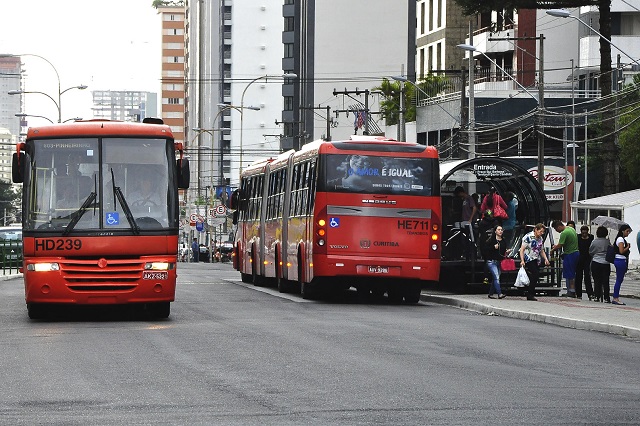Curitiba Is Evolving But Remains a Model for Urban Sustainability
Published on 13 April 2022 by TheCityFix - a blog by the World Resources Institute (WRI)'s Ross Center for Sustainable Cities
Author: Darío Hidalgo
In this article, Professor Darío Hidalgo from Pontifical Xavierian University in Bogotá sheds light on numerous good practices in sustainable mobility and urban planning from Curitiba in Brazil. Curitiba has successfully implemented a central bus rapid transit system, urban forests and green spaces, zoning and building rights, road safety measures, and a shift towards electric buses.

Curitiba, a historic leader in bus rapid transit, continues to advance sustainable urban development and inspire cities around the world. Photo by Mariana Gil/WRI Brasil
I recently had the pleasure of re-visiting Curitiba, Brazil, thanks to an invitation from the Smart Cities Expo. I made my first pilgrimage in 2000, when Bogotá was implementing its bus rapid transit system, Transmilenio, and returned twice after that. Now, in my first non-virtual conference since the pandemic began, I was impressed all over again with the city’s efforts in sustainable mobility and development.
Planned since the 1960s with high density along key corridors, Curitiba has a unique “trinary system” with a series of corridors built around a central bus rapid transit (BRT) line surrounded by two parallel general traffic roads, zoned for high-rise buildings and mixed use. The city has also maintained many beautiful plazas and parks dedicated to its multicultural heritage and trees, particularly the Araucarias of Paraná, or Brazilian pine. Curitiba has complemented these public green spaces with an extensive downtown pedestrian corridor full of activity and life, as well as architecturally iconic buildings, including the Oscar Niemeyer Museum, the Wire Opera House, the greenhouse and botanical gardens, and the Federal University of Paraná building.
Together, these elements make a city with high density nonetheless feel livable while also encouraging a low-carbon way of life – making walking, cycling and mass transit an accessible and appealing way to get around.
Curitiba continues to look to the future and adapt its transportation systems and design. The city is extending its BRT network with two new corridors with an investment of $247 million supported by the Inter-American Development Bank and the New Bank for Development. It is also shifting to electric buses and introducing information technology to create a new economy, under the “smart cities” concept. Curitiba is also working to adapt flood-prone areas of the city to climate impacts and relocate low-income housing to resilient developments.
Despite its advances in sustainable public transport, the city still faces the challenge of motorization, with the highest rate in Brazil at 1.8 inhabitants per car. To improve road safety, the city has implemented a 50 kilometer per hour speed limit on most arterial roads (some are 40 kph), controlled automatically with traffic cameras. And as the number of cyclists has grown, the city has also worked to implement an extensive bike lane network. But improvements are still needed; some cyclists continue to use the direct BRT corridors, for example, which is unsafe for both cyclists and bus passengers.
Curitiba nevertheless remains widely regarded as a leader in sustainable urban planning, and particularly in transit-oriented development. Its successes are the result of multiple fortunate events: a strong work ethic inherited from extensive immigration waves; a group of planning professionals led by Jaime Lerner that questioned and shifted away from modern planning practices that prioritized the automobile and sprawled development; very strong continuity in local and state governments, with mayors nominated or elected several times, which helped sustain key policies and visions; and productive, collaborative dialogue with private sector leaders. The most notable factor may be having the same master plan since 1966, which has been updated and improved over the years to continue and build on the sustainable, people-oriented approach to development led by Lerner and his peers.
Of course, every city is different in size, characteristics and heritage, and no city can copy Curitiba exactly. But its good practices can be adapted to many contexts – as has been the case with BRT.
Bogotá, for instance, adapted the Curitiba bus corridors for its own needs starting in 1998, thanks to the “out-of-the-box” designs by Pedro Szasz and Paulo Custodio, among others, working with Colombian professionals. The BRT in Bogotá is similar to Curitiba’s but able to carry four times as many passengers. Curitiba pioneered tube stations with prepayment and large bi-articulated buses, and Bogotá was the tipping point in adoption of similar systems elsewhere. Now, 181 cities around the world have BRT systems. It is one of the most enduring urban planning ideas to come out of Latin America and is transforming mobility around the globe.
The high capacity of BRT, its fast implementation and relative low cost makes it a critical component of integrated mass transit, along with metro rails. It is always important to evaluate alternatives using costs and impacts, with guides like this one from the World Bank.
Cities can also learn and adapt ideas from Curitiba’s focus on public green space and pedestrian corridors. The city’s mix of urban forests with recreational, sports and event space gives residents 64 square meters of open space per person. Curitiba’s economic approach to urban planning also offers lessons, like with zoning and building rights, which have created funding for urban improvements.
Through Curitiba’s enduring but ever-evolving approach to urban planning, the legacy of Jaime Lerner continues to push sustainable urban development in cities around the world.
A version of this article was originally published in El Tiempo.
Retrieved from https://thecityfix.com/blog/curitiba-is-evolving-but-remains-a-model-for-urban-sustainability/
